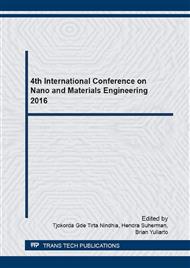[1]
L. -Z. Fan, T. Xing, R. Awan, and W. Qiu, Studies on lithium bis(oxalato)-borate/propylene carbonate-based electrolytes for Li-ion batteries, Ionics (Kiel)., vol. 17, no. 6 (2011) 491–494.
DOI: 10.1007/s11581-011-0551-5
Google Scholar
[2]
Y. -H. Li, X. -L. Wu, J. -H. Kim, S. Xin, J. Su, Y. Yan, et al., A novel polymer electrolyte with improved high-temperature-tolerance up to 170 °C for high-temperature lithium-ion batteries, J. Power Sources, vol. 244 (2013) 234–239.
DOI: 10.1016/j.jpowsour.2013.01.148
Google Scholar
[3]
X. Wang, C. Gong, D. He, Z. Xue, C. Chen, Y. Liao, et al., Gelled microporous polymer electrolyte with low liquid leakage for lithium-ion batteries, J. Memb. Sci. vol. 454 (2014) 298–304.
DOI: 10.1016/j.memsci.2013.12.016
Google Scholar
[4]
W. Li, Y. Xing, X. Xing, Y. Li, G. Yang, and L. Xu, PVDF-based composite microporous gel polymer electrolytes containing a novelsingle ionic conductor SiO2(Li+), Electrochim. Acta vol. 112, (2013) 183–190.
DOI: 10.1016/j.electacta.2013.08.179
Google Scholar
[5]
J. Nunes-Pereira, C. M. Costa, and S. Lanceros-Méndez, Polymer composites and blends for battery separators: State of the art, challenges and future trends, J. Power Sources vol. 281 (2015) 378–398.
DOI: 10.1016/j.jpowsour.2015.02.010
Google Scholar
[6]
L. Larush-Asraf, M. Biton, H. Teller, E. Zinigrad, and D. Aurbach, On the electrochemical and thermal behavior of lithium bis(oxalato)borate (LiBOB) solutions, J. Power Sources vol. 174, no. 2 (2007) 400–407.
DOI: 10.1016/j.jpowsour.2007.06.171
Google Scholar
[7]
K. Xu, S. Zhang, and T. R. Jow, LiBOB as Additive in LiPF6-Based Lithium Ion Electrolytes, Electrochem. Solid-State Lett. vol. 8, no. 7 (2005) A365.
DOI: 10.1149/1.1924930
Google Scholar
[8]
X. Cui, H. Zhang, and S. Li, Electrochemical performances of a novel lithium bis (oxalate) borate-based electrolyte for lithium-ion batteries with LiFePO4 cathodes, Ionics (2014) 789–794.
DOI: 10.1007/s11581-013-1034-7
Google Scholar
[9]
B. T. Yu, W. H. Qiu, F. S. Li, and L. Cheng, Comparison of the electrochemical properties of LiBOB and LiPF6 in electrolytes for LiMn2O4/Li cells, J. Power Sources vol. 166, no. 2 (2007) 499–502.
DOI: 10.1016/j.jpowsour.2007.01.038
Google Scholar
[10]
V. Aravindan and P. Vickraman, A study on LiBOB-based nanocomposite gel polymer electrolytes (NCGPE) for Lithium-ion batteries, Ionics vol. 13, no. 4 (2007) 277–280.
DOI: 10.1007/s11581-007-0106-y
Google Scholar


